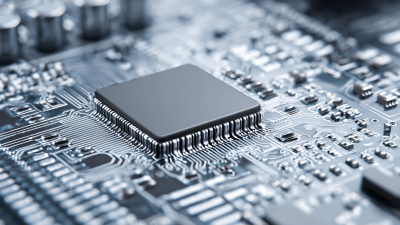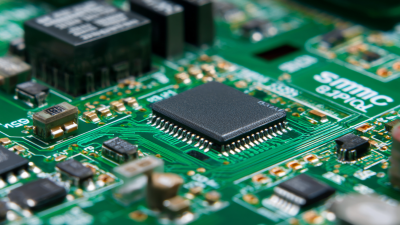Exploring the Future of Smt Pcb in the Context of the 2025 China Import and Export Fair with Industry Insights
Table of Contents
- Future Trends in SMT PCB Technology for 2025 China Import and Export Fair
- Impact of Global Supply Chain on SMT PCB Production and Trade
- Emerging Markets and Their Role in SMT PCB Exports
- Innovations in SMT PCB Design and Manufacturing Processes
- Sustainability Practices in SMT PCB Production for Future Markets
- Analysis of Consumer Demand for SMT PCBs at International Trade Events
- FAQS
- Conclusion
- Related Posts
As we gear up for the 138th China Import and Export Fair in 2025, it’s clear that the electronics industry—especially in SMT PCB manufacturing—is about to see some pretty exciting changes. Zhuhai Xinrunda Electronics Co., Ltd., which has been around since 2004, is really leading the charge in this evolving scene. They offer a full range of electronics manufacturing services, including SMT, PTH, and COB. Industry reports suggest that the global SMT market is expected to grow at a compound annual rate of over 8% through 2025, mainly because folks want smaller, more efficient gadgets. The upcoming fair is going to be a huge opportunity for industry players to show off their latest innovations and team up, helping SMT PCB tech reach more sectors than ever before. As innovation keeps shaking up how things are made, Xinrunda is dedicated to using its expertise to keep up with the industry’s fast-paced changes and play a part in shaping the future of electronic manufacturing.

Future Trends in SMT PCB Technology for 2025 China Import and Export Fair
The SMT PCB industry is really gearing up for some exciting changes, especially with the upcoming 2025 China Import and Export Fair. Thanks to rapid tech advancements and the rising global appetite for electronics, we’re seeing some key trends that are pretty much reshaping how SMT PCB tech develops. Innovations like high-density interconnects (HDI), flexible printed circuit boards (FPCBs), and improved surface mount tech are leading the way. These will allow manufacturers to make smaller, more efficient, and ultra-reliable products—pretty impressive stuff!
As everyone gets ready for this big event, it’s super important to stay on top of these emerging trends. Here's a little tip: try focusing on adding automation and AI into your PCB manufacturing processes. It can really boost efficiency and help cut down on mistakes. Not only does this meet the growing demand, but it also keeps you aligned with international quality standards. Oh, and don’t forget about working closely with your suppliers to streamline sourcing—just so you can avoid any hiccups in your supply chain.
Another trend that’s gaining serious traction is sustainability. Everyone’s pushing for greener manufacturing practices, like using lead-free solder and recyclable materials in PCB building. If you’re thinking ahead, investing in R&D for sustainable tech is definitely the way to go. It’s a smart move that can make your brand more appealing to eco-conscious buyers and keep you compliant with changing regulations. Jumping on these trends for the 2025 China Import and Export Fair could really set your business up for success in this rapidly evolving global market.
Exploring the Future of Smt Pcb in the Context of the 2025 China Import and Export Fair with Industry Insights - Future Trends in SMT PCB Technology
| Trend | Description | Impact on Industry | Projected Growth Rate (%) | Key Technologies |
|---|---|---|---|---|
| Miniaturization | Reduction in size of PCBs while maintaining performance | Increased demand for compact electronic devices | 15% | High-density interconnects, advanced materials |
| Flexible PCBs | Use of flexible materials allowing for bending and folding | Enhancement in product design and durability | 20% | Polyimide substrates, advanced manufacturing techniques |
| Sustainability | Focus on eco-friendly materials and manufacturing processes | Regulatory compliance and consumer demand for green products | 25% | Biodegradable materials, energy-efficient production |
| High-Frequency PCBs | PCBs designed for high-speed signals and communications | Demand in telecommunications and advanced computing | 18% | Low-loss dielectric materials, RF design techniques |
| Smart PCBs | Integration of sensors and connectivity features | Rise of IoT applications and smart devices | 30% | Embedded systems, IoT protocols |
Impact of Global Supply Chain on SMT PCB Production and Trade
You know, the global supply chain really plays a huge role in how SMT (Surface Mount Technology) PCBs are produced and traded—especially as we get closer to the 2025 China Import and Export Fair. Companies like Zhuhai Xinrunda Electronics are navigating this constantly changing landscape, dealing with everything from rising material costs and geopolitical tensions to the push for just-in-time delivery systems. It’s a lot to juggle! The complexity of these supply chains means firms need to be flexible and creative if they want to stay competitive.

That fair honestly serves as a key spot for showcasing new ideas and innovations. Industry players need to bring their A-game in SMT and other electronic manufacturing services to attract international partners and investments. Zhuhai Xinrunda really exemplifies this spirit—they provide a full range of manufacturing services, including SMT, PTH, and COB, to meet the diverse needs of clients across different industries. As global trade keeps shifting, being quick to adapt to changing demands will be crucial if they want to keep growing and streamline their supply chains in this fast-moving high-tech electronics world.
Emerging Markets and Their Role in SMT PCB Exports
As we get closer to the 2025 China Import and Export Fair, there's definitely a shift happening in the Surface Mount Technology (SMT) PCB market, especially with more emerging countries stepping into the spotlight. Countries like India, Brazil, and those in Southeast Asia are really starting to make their mark in the global electronics supply chain. Honestly, these regions are bursting with opportunities for SMT PCB exports—they've got rapidly growing consumer electronics markets and improving tech infrastructure, after all. Companies like Zhuhai Xinrunda Electronics are in a good position to benefit from this trend by adapting their services to meet the specific needs of these emerging markets.
Zhuhai Xinrunda Electronics, founded back in 2004, has already built a solid reputation in high-tech electronics manufacturing. They offer a bunch of solutions—think SMT, PTH, COB, coating services—and they've really honed their expertise over the years. With their background in advanced manufacturing, they’re well-equipped to tap into the increasing demand from these up-and-coming regions. For these markets, quality and innovation are key—companies want reliable partners that can support their rapid growth in electronics production and consumption. By engaging with these new markets, Xinrunda isn’t just expanding its export opportunities—it’s also building long-term relationships that could really fuel sustained growth down the line.
Innovations in SMT PCB Design and Manufacturing Processes
The world of Surface Mount Technology (or SMT for short) in PCB design and manufacturing is really gearing up for some big changes, especially as we get closer to the 2025 China Import and Export Fair. If you’ve been following industry trends, you’ve probably noticed a buzz about the push for more innovative processes to boost efficiency and improve product quality. According to a recent report by MarketsandMarkets, the global SMT market is expected to hit around $47.9 billion by 2026 — mainly thanks to advances in automation and miniaturization. This means manufacturers need to stay flexible, exploring new design approaches and manufacturing methods that can keep up with the growing complexity of electronic parts.
There’s also some pretty exciting tech coming into play, like AI and Machine Learning, which are totally transforming how we design and produce PCBs. These tools help with things like predictive maintenance, bumping up yield rates, and tightening quality control. For example, a study from IPC/WHMA found that companies using AI in their processes saw roughly a 30% drop in production defects. Plus, working closely with suppliers who focus on cutting-edge materials and 3D printing is opening doors to more sustainable and streamlined production cycles. When all the industry leaders gather at the upcoming fair, you can bet that these innovations will be at the forefront — shaping what the future of SMT PCB manufacturing looks like.
Sustainability Practices in SMT PCB Production for Future Markets
As the electronics world keeps evolving, one thing that's really coming into focus is sustainability—especially when it comes to making Surface Mount Technology (SMT) printed circuit boards (PCBs). The upcoming 2025 China Import and Export Fair is a great chance for everyone involved to check out the latest in eco-friendly innovations. These days, manufacturers are leaning more and more toward using greener materials and smarter production methods that cut down on waste and help lower carbon footprints. It’s a win-win: not only does it help the environment, but it also aligns perfectly with what consumers are craving—more responsible sourcing and production.

One cool tip is to incorporate recyclable materials into PCB designs—that’s a real game-changer for cutting down environmental impact. Also, switching to energy-efficient machinery and streamlining processes can make a big difference in conserving resources during production.
Plus, the focus on sustainability is actually reshaping the market. More companies are jumping on board with life cycle assessments, which help improve product durability and recyclability. Working with suppliers who share a commitment to being eco-friendly can really give SMT PCB producers a leg up, both locally and internationally. As everyone gears up for the fair, businesses that put sustainability front and center will probably stand out—especially with customers who care about the planet.
And here’s a little extra tip: teaming up with others on sustainability projects can really boost your efforts and spark some innovative ideas in PCB design and manufacturing.
Analysis of Consumer Demand for SMT PCBs at International Trade Events
The demand for Surface Mount Technology (or SMT) PCBs is really picking up speed, especially with big events like the 2025 China Import and Export Fair coming up. If you’ve been following the industry news, you know that the global market for SMT PCBs is expected to hit around $70 billion by 2025. Why? Well, it’s mainly because electronic gadgets are getting smaller and more powerful, and there’s a huge push toward IoT—everything connecting in smarter ways. At trade shows, companies get a chance to show off their latest SMT PCB solutions that meet the growing need for better connectivity, efficiency, and, of course, sustainability.
When businesses talk to international clients, really understanding what customers want is pretty important. A recent survey found that about 62% of trade fair attendees prefer working with suppliers who care about the environment. That just shows how much sustainability influences buying decisions nowadays. For manufacturers, jumping on the eco-friendly bandwagon—like making greener SMT PCBs—could be a smart move that helps them stand out in this competitive market.
A quick tip: when you’re at any trade event, don’t just talk about your product—highlight what makes it special, especially your efforts to be eco-friendly. Chat with visitors to get a better sense of what they’re actually looking for, and maybe even do some surveys on the spot. This kind of real-time feedback can give you some great ideas for refining your products and positioning your business for success in this ever-changing landscape.
FAQS
: The global supply chain significantly affects SMT PCB production and trade due to fluctuating material costs, geopolitical tensions, and the necessity for just-in-time delivery systems, compelling manufacturers to adopt adaptive strategies for competitiveness.
The fair serves as a crucial platform for showcasing innovation and allows industry players to attract international partnerships and investment while highlighting their expertise in SMT and electronic manufacturing services.
Zhuhai Xinrunda Electronics provides comprehensive manufacturing services, including Surface Mount Technology (SMT), Plated Through Hole (PTH), and Chip-On-Board (COB), to meet the diverse needs of clients across various sectors.
There is a growing demand for innovative processes to enhance efficiency and product quality in SMT PCB design and manufacturing, driven by advancements in automation and miniaturization.
The global SMT market is expected to reach $47.9 billion by 2026, indicating robust growth fueled by technological advancements and increased complexity in electronic components.
AI and Machine Learning are transforming SMT PCB manufacturing by enabling predictive maintenance, improving yield rates, and enhancing quality control, leading to an average reduction of 30% in production defects for manufacturers that implement these technologies.
Collaborating with suppliers that specialize in advanced materials and 3D printing technologies fosters more sustainable and efficient production cycles, which is vital in meeting evolving industry demands.
Innovations such as AI integration, advanced materials, and 3D printing technologies are anticipated to be showcased at the fair, promising to redefine SMT PCB manufacturing practices.
Conclusion
So, I recently came across an article titled 'Exploring the Future of SMT PCB in the Context of the 2025 China Import and Export Fair,' and let me tell you, it really dives into how SMT PCB tech is changing and what we can expect at the upcoming fair. With all the craziness in global supply chains right now, it seems like emerging markets are playing an even bigger role in pushing SMT PCB exports. Oh, and the article also talks about cool innovations in design and manufacturing—stuff like making processes more sustainable to keep up with future market needs.
From a business perspective, it’s interesting to see how customer demand at international trade shows is shaping the strategies of companies like Zhuhai Xinrunda Electronics Co., Ltd. — a serious player in the electronics manufacturing world. Founded back in 2004, Xinrunda has built a solid reputation for quality across SMT, PTH, and COB processes. They’re well-positioned to handle whatever shifts come their way in this rapidly changing industry, which is pretty exciting if you ask me.
Related Posts
-

Exploring Innovative Alternatives for Smt Pcb Solutions in Global Procurement
-

Understanding SMT PCB Board Standards and How to Choose the Best for Your Needs
-

Step-by-Step Guide to Successfully Navigating Custom PCB Assembly for Your Business Needs
-

How to Choose the Right Turnkey Assembly Services for Your Business Needs
-

7 Compelling Reasons to Choose the Best Gold Wire Bonding Solutions for Your Needs
-

Ultimate Checklist to Choose the Best Motherboard with Processor for Your Build
Blog Tags:

